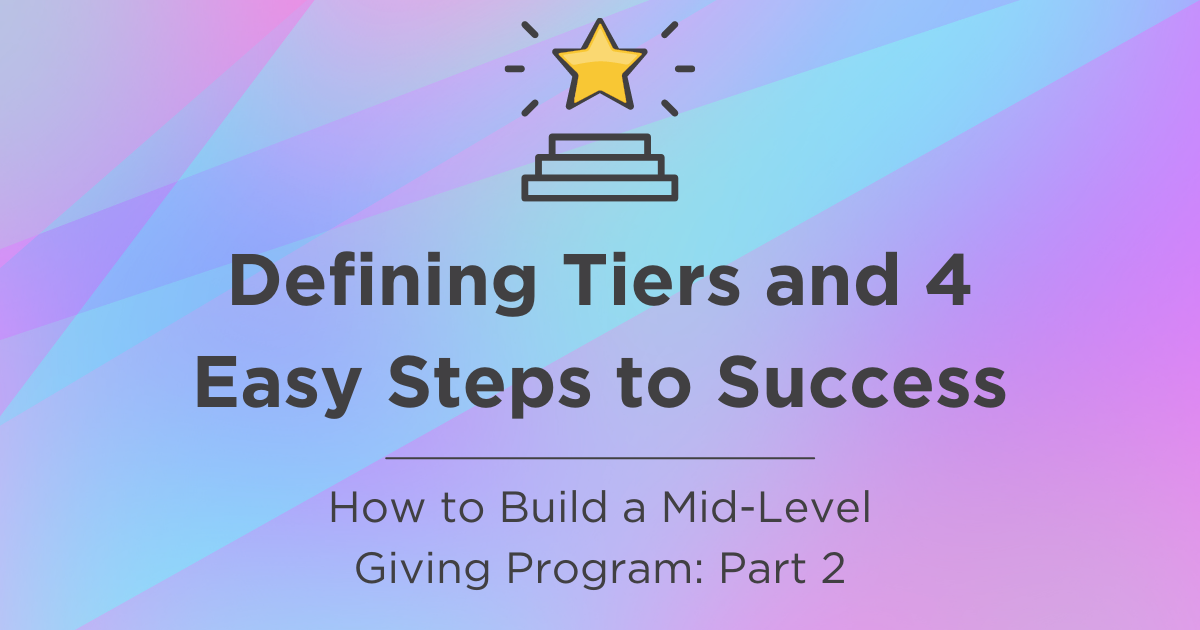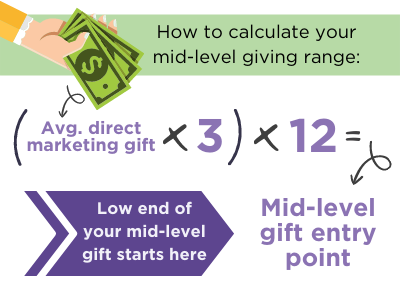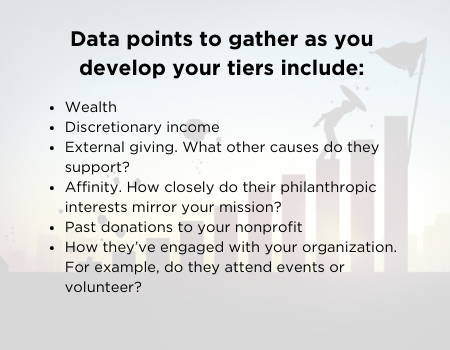We're thrilled to announce we've been nominated for a Webby Award! View our entry and vote.
How to Build a Mid-Level Giving Program - Part 2 of 4
Defining Tiers and 4 Easy Steps to Success

Download all 4 Parts of our eBook
Congratulations! You’ve successfully convinced leadership at your nonprofit to allocate funding for a mid-level giving program. Or maybe you’ve begun making the case and want to present concrete details about how the program will come together.
You’ve come to the right place. Here, we’ll cover the building blocks that compose the foundation of your soon-to-be flourishing mid-level giving program. From understanding what “mid-level” means for your organization to learning the skills and traits that best characterize the colleagues who head up a mid-level program (as well as what they actually do in their roles), we run through what it takes to start a program from scratch.
Let’s get started!
First Step: Defining Your Mid-Level Tier(s)
Mid-level donors fall somewhere between your direct marketing audience (your one-to-many fundraising efforts) and major-gifts donors (who you cultivate with one-to-one relationships). The precise dollar amounts that characterize your mid-level program will depend on the organization, but common approaches for defining it include:
- Taking the top 5 percent of your mass-market audience
- Choosing a range from, say, $1,000 to $10,000 (or up to whatever your major-gifts threshold may be) that a donor contributes yearly
- Applying the following equation:

So, if your average direct marketing gift is $25, you multiply that by three, which yields $75. Then, you multiply that number by 12, giving you the low end of your mid-level; in this example, that would be supporters who contribute $900 annually.
Whichever method you choose, once you have the parameters established, you’ll want to revisit your file and see how many constituents fit the profile. Can you provide an elevated experience to all of them or perhaps some portion of the most valuable? Consider your staff’s capacity when answering that question. For instance, if your mid-level consists of 3,000 names, you may not have the staff to adequately execute the program, which typically involves frequent personal and personalized outreach. If that’s the case, then feel free to recast the net — maybe you move the lower end up to shrink your mid-level pool to a more manageable size, for example. Remember, you’ll keep mid-level in your current direct marketing stream, so it’s ok if you can’t provide everyone a more personal experience.
Again, what’s manageable depends on your staff’s capacity. If your nonprofit is planning on having a dedicated mid-level gifts officer, their list will be larger than what your major gifts officers typically handle. So, if your major gifts officer is responsible for about 125 to 150 donors, then a mid-level gifts officer may handle 250 to 400 names if they don’t have other duties, such as coordinating the organization’s annual fundraising effort.
No matter the size of your mid-level group, you’ll want to create tiers to help you strategize tasks. For the entry tier, which will comprise the majority of your mid-level donors, elevated email and mail outreach will suffice. Above them will sit a group that you or your team can personally cultivate, and at the very top will be a much smaller stratum that you’ll want to pass along to your colleagues in major gifts.
Let data be your guide in creating this hierarchy with a tool like Pursuant’s GivingDNA. The right platform can help you be more efficient, effective, and hasten time-sucking tasks, freeing you and your team to focus on relationship-building initiatives. If your tech stack isn’t robust enough to automate segmentation tasks or identify prospects, consider leveling up.

Such data can give your fundraising efforts a real boost. Take, for example, the experience of CESC, a social services nonprofit in Florida. Due to unexpected and expensive operational changes brought on by the pandemic, the organization needed to raise their revenue by 50 percent at EOY 2020. Using GivingDNA to uncover their constituents’ philanthropic affinities, demographics, and wealth, CESC and Pursuant worked together to identify discrete audiences. CESC then took those insights and drafted messaging that aligned with the different groups for targeted communications to prompt a greater response and, hopefully, higher levels of giving. In other words, CESC built one-to-many communications that felt relevant and highly personal. Would the effort pan out?
The results were indeed impressive. With a collective response rate of 12 percent from the segmented audiences and an average gift size of $197, CESC raised $124,000 in the months of November and December alone. By year’s end, the nonprofit had grown its YOY revenue by 84 percent, a full 34 percentage points higher than their initial goal of 50 percent, suggesting that the right combination of software and communications strategy can make an outsized impact on an organization’s fundraising.
Success in 4 Steps
Tools like GivingDNA will enrich your efforts, but they’re just one part of the equation. There are a few other factors to keep in mind.
- Build a Winning Team
Once you have the right tools in place, you need a team that can properly wield them. What personalities and skill sets are best suited for that?
Ideally, you want to find teammates who have a collaborative mindset because mid-level giving programs require partnering with direct marketing and major gifts teams. Along those same lines, candidates who excel at relationship-building should rise to the top. Mid-level giving programs involve cultivating relationships with donors who may be passed on to major gifts, so someone who can seed those kinds of high-touch engagements will be key.
If candidates also have a background in both direct marketing and major gifts, even better. Strong data analysis skills will round them out.
- Establish a Cross-Functional Workflow
Once you have the right team in place, establish a workflow with the direct marketing and major gifts teams. Together with both, map the complete donor journey to identify all the touchpoints across the organization. The exercise will cut across silos, channels, and donor levels, helping teams better understand the global effort involved in meeting the organization’s mission.
“You’ll uncover opportunities to surprise and delight donors, as well as chances to engage them in more meaningful ways,” says Ryan Carpenter, vice president of client success at Pursuant. “It’s really important that every member of those teams plays a part in that conversation and understands their unique contribution in creating the ideal donor experience.”
In short, you’re getting buy-in throughout the organization, and you’re establishing a transparent workflow that everyone can follow. For instance, when a donor gives X amount, your colleagues in direct marketing will give you a head’s up that the donor has just upgraded to mid-level. Conversely, when a donor has been primed for major gifts, you’ll reach out to that team.
- Goodbye Donor Pyramid, Hello Donor Vortex!
Remember, though, that donor identities are fluid. They may flow between mid-level and major gifts back to the annual fund — and that’s OK. “Mid-level isn’t a tenured position,” says Carpenter. “Just because a donor gave you a qualifying gift eight years ago, and now they give you $50 per year, it doesn’t mean they should be on your mid-level list. You’re trying to create an elevated experience for those who are currently supporting you at the mid-level. It’s OK if some drop back into your annual fund group.”
To stay on top of that fluidity, monitor your data on a regular basis — perhaps quarterly. Track who’s new, who’s in danger of lapsing, and who you’ve lost. Rejigger strategies and tasks based on the data.
- Inventory Your Content
You’ll also want to conduct a content audit of what your teammates in mass marketing and major gifts have. Do they have evergreen content you can adapt? Is there a content gap you need to fill that’s specific to mid-level donors?
Listening exercises and tools can help answer those questions. Consider the output from surveys, focus groups, and phone calls, as well as A/B tests of your communications. Are some messages resonating better than others? What about social media or digital listening tools for tracking behavior and actions? “Those can all be good indicators of your donors’ desire to engage with your organization in a deeper way, as well as help you understand how they want to engage,” says Carpenter.
Continue to part three: branding, metrics, and more.
The GivingDNA Platform leverages 20+ years of experience from the Pursuant Fundraising Direct Response Agency. Connect with an agency representative today if you’re looking for an expert’s help with your mid-level giving program.
